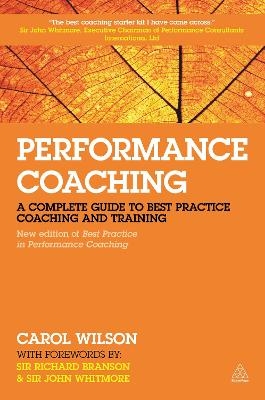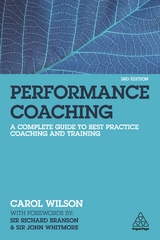
Performance Coaching
Kogan Page Ltd (Verlag)
978-0-7494-7031-9 (ISBN)
- Titel erscheint in neuer Auflage
- Artikel merken
Performance Coaching offers a guide to the fundamentals of coaching with an overview of all the key principles, tools and case studies you need to develop more advanced knowledge. Whether you're thinking about becoming a coach, already running a professional coaching practice or thinking about how you can embed a coaching culture in your organization, Carol Wilson illustrates how to develop a best practice approach. Using practical tools throughout and with international case studies to illustrate the various cultural challenges coaches and managers can face, Performance Coaching is a complete resource for developing coaching in any organization. This new edition of Performance Coaching has been completely updated to offer a greater focus on building a coaching culture in organizations and the challenges that leaders face in understanding and developing a coaching approach.
International speaker, writer and broadcaster Carol Wilson worked at board level with Sir Richard Branson during the early years of Virgin and was the first woman to found her own chart topping record label (Dindisc). Carol is now Managing Director of Performance Coach Training, sits on the Global Advisory Panel to the Association for Coaching, is a Trustee to charity The Ministry of Entrepreneurship and a Fellow of The Professional Speaking Association. Carol designs and, through her team of international trainers, delivers, coaching and leadership programmes all over the world to corporations and public sector organisations.
Section - ONE: The fundamentals of performance coaching;
Chapter - 01: What is coaching?;
Chapter - 02: The differences between coaching, therapy, counselling, mentoring and consultancy;
Chapter - 03: The directive–non-directive continuum;
Chapter - 04: Self-limiting beliefs;
Chapter - 05: Coaching and neuroscience;
Section - TWO: Creating a coaching culture in organizations;
Chapter - 06: The meaning of a coaching culture;
Chapter - 07: Ten steps to creating a coaching culture;
Chapter - 08: Coaching in the workplace;
Chapter - 09: Coach training in the workplace;
Chapter - 10: Coaching in leadership;
Chapter - 11: Cross-cultural coaching;
Chapter - 12: Coaching in schools;
Chapter - 13: Coaching for Crisis at Christmas;
Chapter - 14: Corporate social responsibility and shared value: bringing business and society back together;
Chapter - 15: Bullying in the workplace;
Chapter - 16: Resilience in leadership;
Chapter - 17: Coaching supervision: a workplace perspective;
Chapter - 18: ROI: Measuring the return on investment in coaching;
Section - THREE: Skills for coaches and managers;
Chapter - 19: Listening;
Chapter - 20: Reflecting, summarizing and clarifying;
Chapter - 21: Questioning;
Chapter - 22: Permission protocol;
Chapter - 23: The GROW coaching model;
Chapter - 24: The EXACT model: a coaching approach to goal setting;
Chapter - 25: Coaching feedback;
Chapter - 26: The structure of coaching;
Chapter - 27: Setting and reviewing actions;
Section - FOUR: Tools of the trade: continuing professional development;
Chapter - 28: David Grove’s Clean Language;
Chapter - 29: David Grove’s Emergent Knowledge;
Chapter - 30: Transpersonal Coaching;
Chapter - 31: An introduction to neuro-linguistic programming;
Chapter - 32: Systemic Coaching;
Chapter - 33: Transactional Analysis and the OK Corral;
Chapter - 34: 360-degree feedback;
Chapter - 35: The Reuven Bar-On Emotional Quotient inventory (BarOn EQ-i);
Chapter - 36: Thomas-Kilmann Conflict Mode Instrument;
Chapter - 37: Marshall Rosenberg’s ‘Non-Violent Communication’;
Chapter - 38: Situational Leadership;
Chapter - 39: Kouzes and Posner: The Leadership Challenge;
Chapter - 40: Cultural Transformation Tools;
Chapter - 41: The Inner Game;
Chapter - 42: Nancy Kline’s Thinking Environment;
Chapter - 43: Appreciative Inquiry;
Chapter - 44: Mindfulness;
Chapter - 45: Elizabeth Kubler Ross’s Change Curve six stage model;
Chapter - 46: Bruce Tuckman’s ‘forming, storming, norming and performing’ team development model;
Chapter - 47: The Myers-Briggs Type Indicator (MBTI®);
Chapter - 48: The Enneagram;
Chapter - 49: Kolb’s learning styles;
Chapter - 50: DISC;
Chapter - 51: Johari Window;
Chapter - 52: More team role models
| Erscheint lt. Verlag | 3.1.2014 |
|---|---|
| Verlagsort | London |
| Sprache | englisch |
| Maße | 156 x 234 mm |
| Gewicht | 625 g |
| Themenwelt | Sozialwissenschaften ► Pädagogik ► Berufspädagogik |
| Wirtschaft ► Betriebswirtschaft / Management ► Personalwesen | |
| Wirtschaft ► Betriebswirtschaft / Management ► Unternehmensführung / Management | |
| ISBN-10 | 0-7494-7031-3 / 0749470313 |
| ISBN-13 | 978-0-7494-7031-9 / 9780749470319 |
| Zustand | Neuware |
| Informationen gemäß Produktsicherheitsverordnung (GPSR) | |
| Haben Sie eine Frage zum Produkt? |
aus dem Bereich



